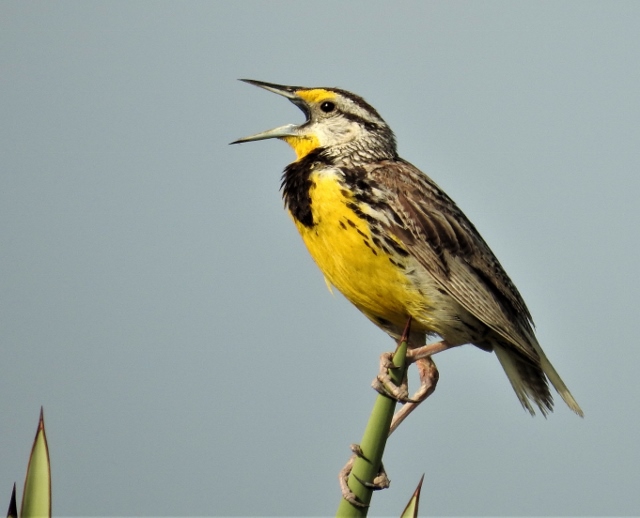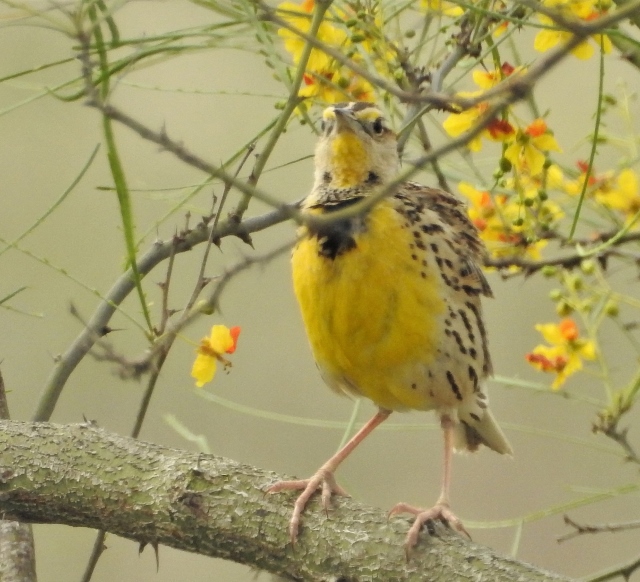by M. Kathy Raines

From the honey-colored fields of the bike trail, I first hear its piping, plaintive call, rather like a kitten’s persistent mewing.
Then I see it — the eastern meadowlark, with its lemon-colored chest painted with a stark black V, its feet clutching a twig, camouflaged by the profuse yellow blossoms of a palo verde tree. What a stunner!

I suppose we locals become used to our array of vivid birds like green jays and great kiskadees, both vociferous residents of our woodlands. I eagerly anticipate our migrants — hooded warblers, indigo buntings, vermillion flycatchers and other — for their dazzling colors. And here was this equally lovely year-round resident of our fields and meadows, right under my nose.
Like everyone in Cameron County, I’ve been confined to my immediate surroundings during Cameron County’s “shelter in place” orders. So, I’ve made do with daily bicycle rides on the nearby Brownsville Historical Battlefield Trail, especially the wilder portion, that north of Alton Gloor. It is here I discovered this beauty.
Both the eastern meadowlark (Sturnella magna) and the western meadowlarks (Sturnella neglecta), both of which thrive here, are not larks, but blackbirds, in the family Icteridae, along with by great-tailed grackles, red-winged blackbirds, cowbirds and orioles. The name comes from a Latin word, “icterus”, which means “jaundiced,” presumably to denote the color in orioles.
The genus “Sturnella,” meaning “starling” in Latin, encompasses both meadowlarks. The eastern meadowlark’s species name “magna” means “great” in Latin; the western one’s name “neglecta,” means “ignored,” as it was not a separate species for some time. The wide-ranging eastern meadowlark population includes 15 subspecies
The eastern meadowlark lives year-round throughout the Southeast, Midwest and parts of New Mexico and Arizona. It also breeds in the Northeast. It flourishes in cultivated and uncultivated fields, meadows, prairies and savannas.
Visitors to wildlife refuges like Laguna Atascosa, which contains broad grasslands, will
likely encounter these birds, as well as wintering western meadowlarks. Pablo Quintanilla of Sabal Palms Sanctuary, which is forested, has seen none there. Javier Gonzalez, naturalist educator at the South Padre Island Birding, Nature Center & Alligator Sanctuary, spots them in grassy regions of the bay flats north of the Convention Center.
Stocky birds, males and females look much the same. Brown streaks adorn their heads and backs, enabling them to blend into the multicolored grasses where they feed and nest. Most distinguishing is the black V-shaped breast band adorning the meadowlark’s yellow chest. White tail feathers flash during the birds’ flight, which consists of shallow wingbeats and short glides.
One can differentiate an eastern meadowlark from a similarly colored bird not only by its grasslands habitat, but also its unique and varied songs consisting of slurred, flutelike whistles that drop in pitch. A male may sing one tune for a while, then switch to another. A study of eastern meadowlarks in New York, using spectrograms, revealed over 100 melodic patterns. The bird makes one sharp call note to deter trespassers and, in flight, makes a “weet” sound.
During warm months, the eastern meadowlark fills up on insects, including larvae, and spiders. It walks through grass, probing the soil with its long beak, snatching prey from the ground and low plants. The bird also consumes grain and weed seeds, spilled corn and wild fruit, especially in the winter when invertebrates may be scarce. Vegetable matter constitutes about a fourth of its diet. During winter, meadowlarks may forage in flocks of over 100.
Eastern meadowlarks breed here during spring and summer, usually producing two broods. A male often has two, sometimes three, mates, while a female usually has one.
A few weeks before mating, a male sets up his territory, signaling his boundaries with flight and song. To attract females and deter competitive males, he points his bill upward, flicks his wings and spreads his tail, fluffing out his chest feathers and displaying his distinct black V. Sometimes, like a mockingbird, he hops straight upwards.
Rivals rarely fight, but struggle fiercely when they do, locking feet, rolling and stabbing, till one bird retreats.
Though eastern meadowlarks often startle and disappear into the grass, this spring on the bike trail, I’ve taken shot-after-shot of these males, persistently singing their hearts out on signs, cables or outer twigs of mesquites.
Prior to mating, the female initiates an aerial chase, during which she makes a series of brief flights, sometimes resting or posturing in between. Then she adopts a receptive position, raising her tail and bill, drooping and quivering her feathers, sometimes chattering. During repeated mating, both birds may make jump-flights, during which they leap about a yard upwards.
Together, the birds choose a nesting site. The female finds an indentation, perhaps a hoof print, amid a grassy field into which she weaves a domed, well-camouflaged grass nest, creating a side entrance. Eager photographers must be wary: a female may abandon a nest if she senses danger.
She lays from three to five brown-speckled white eggs, depositing one per day. Nestlings emerge in from one to fifteen days, fledging eleven or twelve days later. Fledglings become independent in about 21 days, ready to mate the next year. Males may nurture fledglings while the female readies for her second brood.
Though eastern meadowlarks appear to be flourishing in Texas, they face a worldwide decrease. In 2014 Partners in Flight placed them on a list of birds in steep decline, and the International Union for Conservation (IUCN) designates meadowlarks as “near threatened”.”
Some meadowlarks are trampled by livestock or poisoned by pesticides and other contaminants. Harvesters destroy birds and nests. Environmentalists urge farmers to delay mowing until August, when most of the meadowlarks’ nesting is completed.
Since an estimated 95% of eastern meadowlarks live on private lands, the onus is on farmers and other landowners, as well as the state and federal government, to protect these lovely, tuneful creatures.
